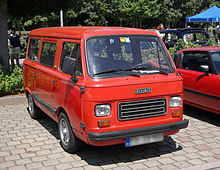Fiat 900
The Fiat 900 is a 6-seater minibus (Familiare) or a delivery van (Furgonetta) produced by the Italian car manufacturer Fiat . It was presented in 1971 as the successor to the Fiat 850 T.
The Fiat 900 is now a fairly unknown cousin of the Multipla . The ancestor is the Fiat Multipla 1, an extended "Familiare" version of the successful 600 model in the 1950s. Fiat discovered the van market for itself and developed the T600, "T" standing for "Trasporto" (German: Transport). Fiat offered the T600 as a minibus on, jumped in the 1960s, the 700 T-series number and developed the 850 T . This development was based on the Fiat 850 and adopted its drive concept with rear-engine and rear-wheel drive.
It was not until the mid-1970s that Fiat introduced the 903 cc engine and with it the 900T , almost chrome-free and overall slightly more angular than its predecessors. The Fiat 900 T has the same engine that was used in the Fiat 127 : a 4-cylinder in-line engine with 903 cm³, but with only 35 HP (26 kW). However, as with the predecessor, the engine is installed at the rear. Furthermore, this results in a reverse direction of rotation of the motor (seen turning to the left in the direction of the clutch) compared to the front motor applications of the same motor such as. B. in the 127, A112, Uno or in early Fiat Pandas (turning to the right), a peculiarity that the 900 T shares with the Fiat 850. There was also a version with electronic ignition box, the Fiat 900 e . A total of 16 body variations were offered: optionally with high roof, folding and sliding doors, as a combination bus and as a luxury bus, there was even a bare chassis without a body on request - probably for camping vehicle developers. The best known variant is the ice cream van type (see photo). The unusual body structure was handcrafted in the Netherlands from fiberglass. A handful of these still exist across Europe today. At the end of the 1970s, the T version was spiced up with, among other things, new interior fittings (partly from in-house model competitors Fiorino and 238). Instead, an "E" now adorned the rear. There was a luxury version called "Panorama", in some markets it was sold as "Pandora". At 14,800 DM, it was around 4,000 DM more expensive than the basic model. This luxury version was very popular as a hotel shuttle in the 1970s and especially in Italy.
In 1981 the bus was discontinued without a successor. The transporter survived the arrival of Japanese competition only briefly. At the beginning of the 80s, Suzuki was the first Far Eastern manufacturer to introduce the Carry, a small van on the European market, which offered massive competition to the 900 in terms of price. Fiat did not withstand the pressure for long and stopped producing vans in 1986. The Austrian licensee Steyr also soon stopped production. Until the beginning of the Balkan War in 1989, the long-time Yugoslav Fiat licensee Zastava continued to build the car as the Zastava 900 AK . The automobile factory in Kragujevac handed over the entire production line to Turkey to the local Fiat partner Tofaş . The 900 series continued to be built there until the 1990s before it was replaced by the current models.

